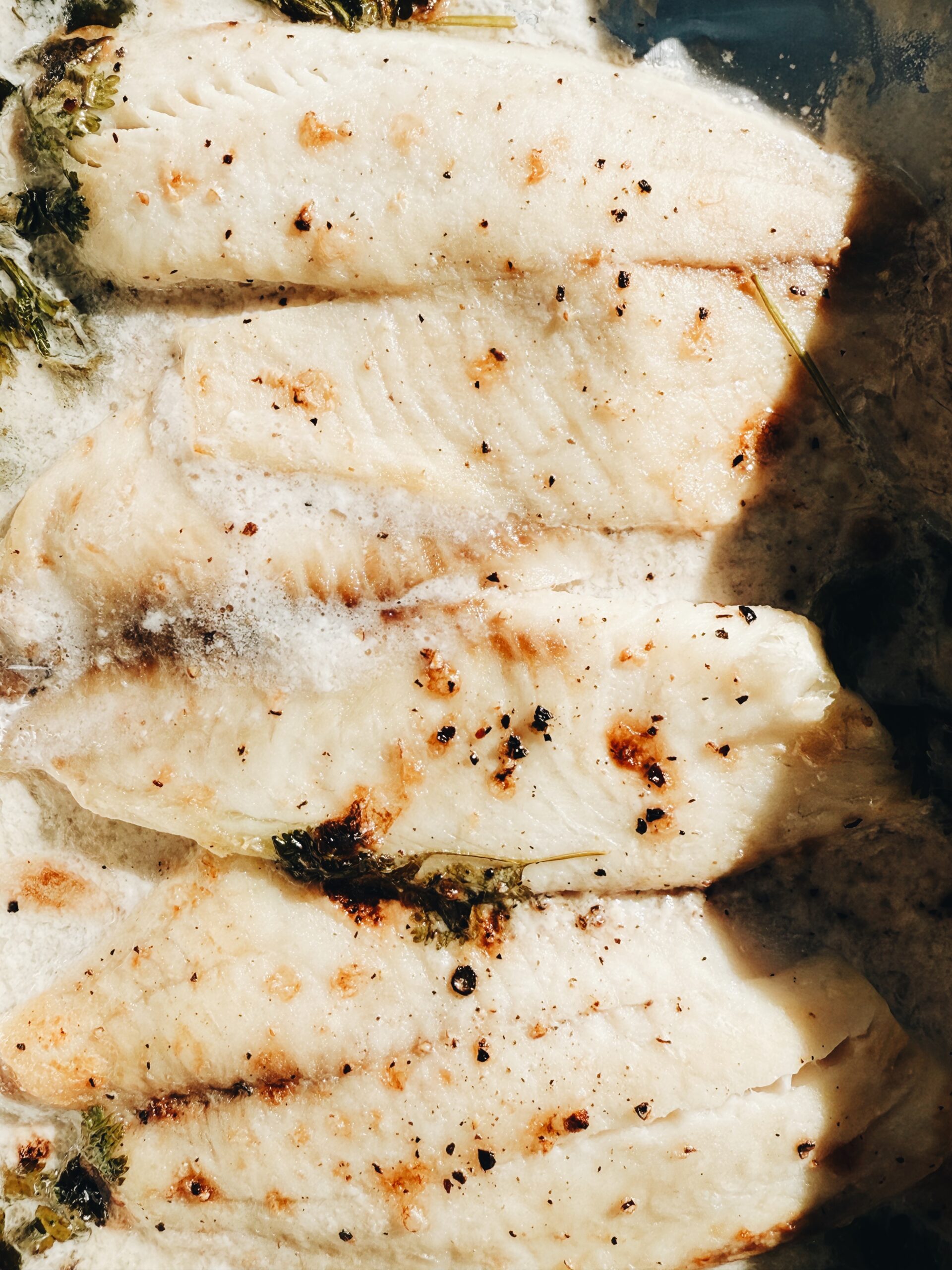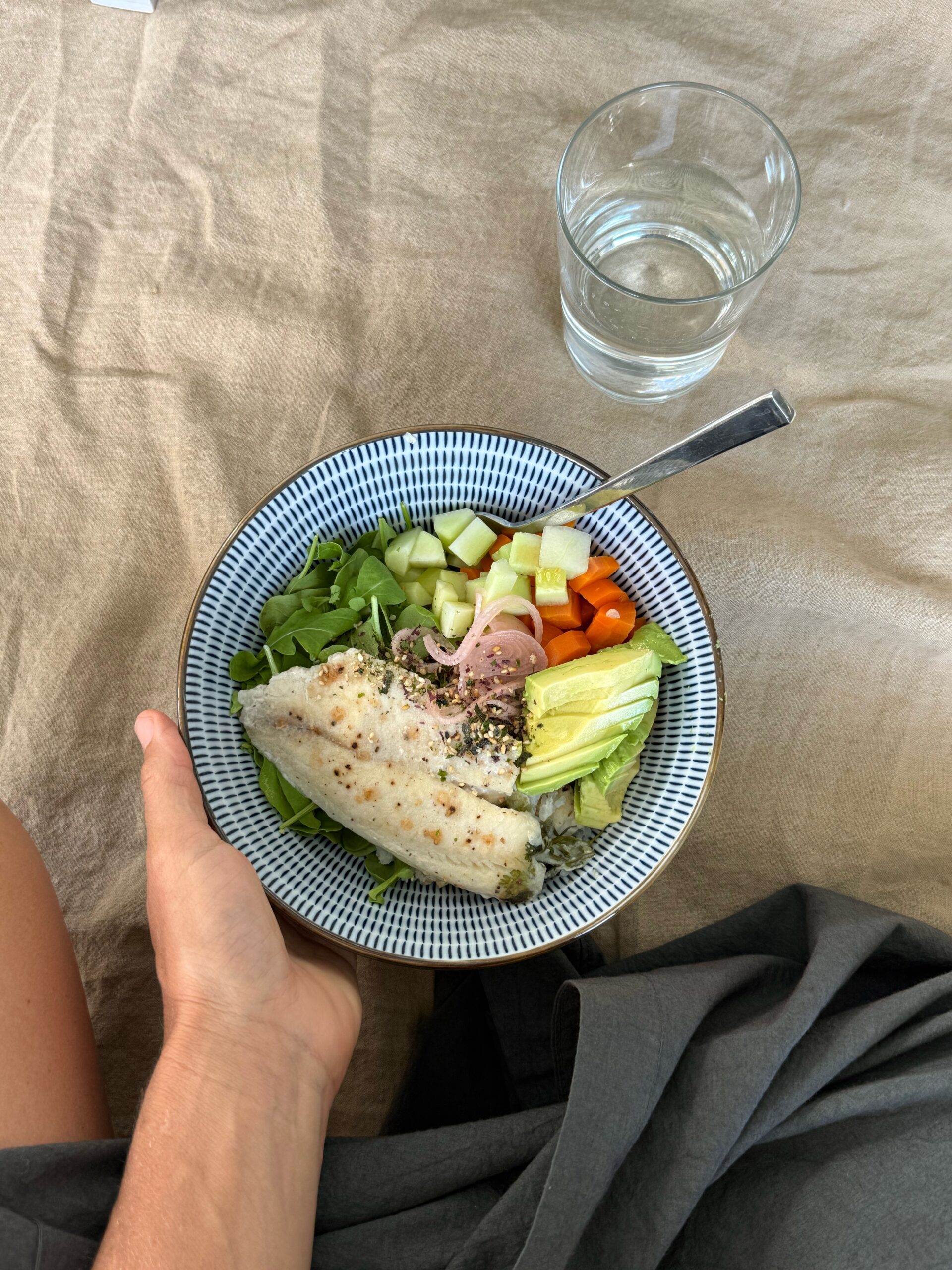

As you might have guessed, Leo’s lunchbox looks a little bit different than other lunchboxes.
First and foremost, this is because over the past months we’ve removed many foods from his diet to reduce his eczema symptoms and cool inflammation in his little body. (Hint: it WORKED.) And, because he’s grown to love so many of our staples – even as he starts to enjoy gluten, dairy, and things like mac n cheese and nut butter sandwiches like *most* 2.5 year olds, we just keep loading his lunchbox with unconventional delicious stuff.
Most of the time, we all enjoy last nights dinner for today’s lunch. With one exception; when I want to make sure he gets a little hit of protein I make this fish. Yes, I do it in the morning, before school because I can – one of the reasons I love this Coconut Braised Tilapia so much is that it literally comes together in 10 minutes, and makes us all feel well cared for for the rest of the day.

It’s true! We don’t eat a lot of fish in our house. The first reason is that my husband can’t eat fin fish – only shellfish. So this beautiful little dish is just for Leo and I! And the second reason is that we live in a land-locked state and salmon, cod, halibut and your usual fish friends aren’t found anywhere near us. We do occasionally enjoy Colorado-caught trout from the many rivers and streams near our home, but generally speaking fish is not a local ingredient for us. So I don’t create a lot of recipes with it. But this one serves many a purpose and it deserves a place here.
This beautiful, cooling little freshwater fish is often knocked on for so many reasons. As a chef and restaurant person, many of my colleagues snub a nose at this affordable option. But there are lots of reasons to love it, and some specific ways to source it to make it sound and frankly, one of the most sustainable options out there.
First to note is that we’re still in summer here, my friends, and pitta is still raging. This dosha doesn’t work well with high-fats, or heavy proteins, and instead we can support pitta dosha by favoring poultry, freshwater fish (over salt water fish) and plant based sources. And here’s where tilapia shines!
Unlike other, oilier fish that come from the ocean, tilapia is a freshwater fish. This makes it lighter in quality, less salty in flavor (and therefore less inflammatory to pitta dosha) and easier to digest. It’s lower in omegas than other fish…but as we remember more is not always better. This lower omega profile also translates to a cooling factor that other fish cannot touch. In fact, tilapia and other fresh water fish are some of the only fish that are cooling and supportive to pitta dosha.
Lastly, tilapia is a lovely protein source without being an oily or heavy food – a feature of many valuable, animal-based proteins. It won’t make athletes or other pitta types feel sluggish or increase body temperature, making it a superstar ingredient.

This is really important. Not all tilapia is created, farmed or caught under equally ecological or supportive conditions. So, to be sure you actually get to benefit from it’s beautiful properties, and make a sustainable choice, keep reading:
Farming practices matter—big time:
In places like the U.S. and parts of Latin America, tilapia can be raised in recirculating systems with low environmental impact. But in China and some Southeast Asian operations, overcrowding, antibiotic use, and water pollution have made headlines. This leaves some people side-eyeing tilapia as a “factory farm fish.” Ask your fishmonger where your tilapia is coming from and make sure it’s coming from a North or South American source.
Look for these certifications/standards:
Aquaculture Stewardship Council (ASC) or Best Aquaculture Practices (BAP): ensures the farm is reducing pollution, not overusing antibiotics, and protecting worker + community health.
USDA Organic: (rare for tilapia, but exists in the U.S.) – stricter feed and water quality standards
I source tilapia from Whole Foods. While they don’t carry a couple of the certifications above, they source their fish from farms that meet their own strict internal standards. The tilapia feed includes fish processing trimmings instead of wild-caught fish, reducing pressure on marine ecosystems. Suppliers undergo third-party audits to ensure compliance with Whole Foods Market’s quality standards. And, they track their tilapia from farm to store, ensuring transparency and accountability in the supply chain.
Is such a beautiful dish in addition to being one of the kitchen hacks that make me feel like a super star in the kitchen – it will make you feel like that too!
If you didn’t want to use tilapia, you could use another tender white fish of your choosing. Note that the flavor profile and the cooking time may vary.
It’s beautifully cooling for pitta dosha, on account of the spices swirled into the coconut milk, the light but powerful protein sourse, and the freshwater nature of the fish, making it a lovely dish for late summer or early fall.
I don’t *always* make it first thing in the morning. Sometimes I make it for dinner and we enjoy it for lunch the next day. Whenever you make it, you’ll find it to be an easy, fresh, light and lovely meal that doesn’t require you to lift much more than a little finger. I love to eat it with a grilled corn + tomato salad with mint, but also am so happy to enjoy it with steamed rice, veggies, or noodles or or or….
That's ok, just sign up or log in to see this recipe.